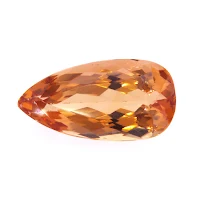What is Topaz?
Topaz is a silicate mineral that comes in various colors. Most people are familiar with topaz in its ubiquitous blue hues. Blue topaz is produced by taking colorless topaz and subjecting it to irradiation and heat, creating a variety of saturations from deep blue to lighter pastel shades. The treatment is permanent, and the value is reasonably consistent so the selection of the most preferable becomes a matter of taste.
Other naturally occurring hues of topaz include brown, orange, pink and rarely red. The value of these hues will be dependent upon how well saturated the color is in the gemstone, with browns being the more common, and consequently more affordable, through the more vibrant shades of orange and pink.
 |
| Photo Copyright ©️ Robert Weldon via GIA |
Imperial Topaz is a trade name that is most often associated with an orangey-pink to pinkish red varieties of the gemstone. The name derives from an early source in the Ural Mountains in Russia. The material was nicknamed "Imperial topaz" in honor of the Russian royal family, who were the only ones allowed to possess and wear this special gem.
History of Topaz
The ancient Egyptians believed that the gemstone topaz was colored by the glow of the sun god, Ra. The ancient Greeks believed topaz had the power to increase strength and make its wearer invisible in times of emergency. Early discoveries of topaz from Brazil adorned the jewelry of the 18th and 19th-century Russian Czarinas, earning the stone the moniker of "Imperial Topaz."
 |
| Photo Copyright ©️ gem-a.com |
Where can you find topaz?
Today, topaz deposits are found in Brazil, the United States, Madagascar, Myanmar (Burma), Namibia, Zimbabwe, Mexico, Sri Lanka, Pakistan, Russia, and China. Topaz can feature the amber-gold of cognac or the blush of a peach and any shade of warm brown or orange in between. Some rare and exceptional examples are pale pink to sherry red. Blue, once the rarest color of topaz, is now the most common due to an enhancement process that turns colorless topaz blue. After the raw topaz is extracted from the Earth and cut, it is irradiated to brown and then heated to sky blue. This enhancement process is permanent.
Varieties of Topaz
Sky Blue Topaz
Sky Blue Topaz is the lightest variety of Blue Topaz (typically around 20% to 30% tone). When they feature great clarity (which they almost always do), they can often look similar to Aquamarine. The name comes from the unmistakable colour of the sky on a crisp, clear spring day, and the lighter tone works hand in hand with the sparkle of the gemstone to make this variety really twinkle and shine. They're almost unbeatable for their beauty when worn as a pair of stud earrings in a good carat weight.
 |
| Photo Copyright ©️ discoveryjewels.com |
Swiss Blue Topaz
This is the name given to any Blue Topaz jewels that are lighter in tone than London Blue Topaz but darker in tone than Sky Blue Topaz. This 'best of both worlds' balance between the two is very popular and is thought to have been named after the colour of the spring sky above the Swiss Alps. Swiss Blue Topaz looks stunning in any precious metal setting, but it seems perfect when set into Sterling Silver, as the neutral colour of the metal lets the bright, vibrant blue of the stone truly shine through.
 |
| Photo Copyright ©️ creslagems.com |
Imperial Topaz
Without question, Imperial Topaz is one of the world's most coveted gemstones. Due to pleochroism, its mesmerizing natural colours effortlessly flow from a vibrant yellow to orange and just occasionally from orange to pink. Imperial Topaz is one of those gemstones that all gem collectors and connoisseurs seek one day acquire. In the 18th century, this gem was hugely popular in Imperial Russia, and it was through this association that the gem most likely received its name. However, if you speak to any mine owner in Brazil, they will tell you that the gem was named in honor of their emperor, Dom Pedro, who claimed Brazil's independence from Portugal in 1822. Because of the richness of its folklore and its natural colours, Imperial Topaz is sold at a premium price.
 |
| Photo Copyright ©️ thegemlab.com |
Galileia Topaz
For a long time, the extra colour was added to the topaz by coating the outside of the gemstones. While the results were undeniably beautiful, this coating could, over time, start to scratch off, revealing the clear topaz underneath. These days, there's a much better way of adding an array of beautiful colours to topaz; it is done by diffusing the colour throughout the entire gemstone using a patented technique developed over many years.
The process is entirely stable and will last a lifetime, so you'll be able to enjoy these exquisite colours forever. Here, we're highlighting Galileia Topaz, a stunning, soft pink variety created using this technique. But there are many other colours available too.
 |
| Photo Copyright ©️ gemporia.com |
Are there Lab-Created Topazs?
Synthetic topaz is created in laboratory settings using techniques such as hydrothermal growth or the Verneuil process, replicating the natural conditions under which topaz forms in the Earth's crust. With a chemical composition similar to that of natural topaz, synthetic varieties are produced in various colors through methods like irradiation, heat treatment, or chemical doping. While sharing many properties with natural topaz, synthetic stones can often be identified through gemological analysis. Despite this, synthetic topaz offers a cost-effective alternative to natural stones, with its affordability and availability making it a popular choice for jewelry and decorative purposes. From vivid blues to delicate pinks and yellows, synthetic topaz provides consumers with a versatile range of options for creating stunning jewelry pieces.
 |
| Photo Copyright ©️ Wuzhou Jiangyuan Gems |
